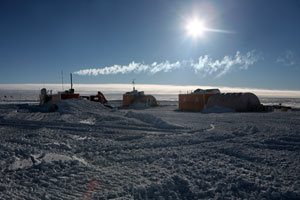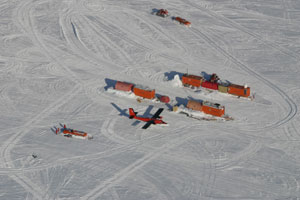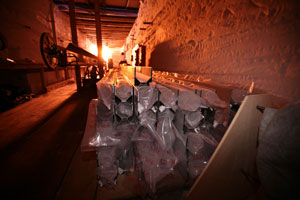|
Ice cores provide climate records from the seasonal to millennial resolution level. Isotope and chemical variations in the deposited snow along with gases within
trapped bubbles provide proxy records for many aspects of the palaeoenvironment, including temperature, snow accumulation rates, moisture sources, atmospheric dust
loading, volcanic ash, greenhouse-gas concentrations, and bioproductivity.
One of the critical scientific questions raised by the TALDICE project concerns the dynamics of the last deglaciation in Antarctica, and in particular the controversial
findings from Taylor Dome (Ross Sea sector) with respect to other Antarctic plateau ice cores (Vostok, Dome C, Byrd, Dome Fuji). A crucial test for theories and models
regarding the causes and mechanisms of rapid climate change is the synchrony or asynchrony and time lag of climate change during the last glacial transition and
stadial/interstadial period in Antarctica and Greenland, and within Antarctica (East Antarctica vs. West Antarctica, coastal site vs. plateau area, Southern Atlantic
Ocean vs. Southern Pacific Ocean). High-resolution Holocene climate and environmental records of the Ross Sea area are needed to characterise interglacial variability
and understand the significance of modern changes. Since the high inland plateau of the Antarctic ice sheet is isolated by distance from local aerosol sources,
chemical-isotopic signals in ice cores from this area are considered reflective of the austral hemisphere environment. Ice cores from the edges of the continent
provide better records of the processes and environmental conditions in coastal areas and the surrounding Southern Ocean.
There are currently only a few ice cores from coastal sites that record Holocene and post-Holocene climate change or the retreat of the ice sheet since the
Last Glacial Maximum (LGM). Accurate knowledge of deglaciation in Antarctica and of environmental conditions (sea ice extension, snow accumulation, temperature, etc.)
since the LGM is important for understanding the past, present and future behaviour of Antarctic mass balance, and hence the cause of Holocene and 20th
century sea-level rises. The investigation of Antarctic deglaciation over millennial time scales with decadal resolution, from the LGM through the Holocene to the present,
should reveal the relative influence of sea level changes (from northern hemisphere deglaciation) and changes in the Antarctic climate (snow accumulation regime) and
Southern Ocean (sea ice extension, El Niño-Southern Oscillation, Southern Annular Mode). TALDICE ice core temporal coverage includes most of the Holocene and the
last glaciation (last 40,000 years) at high resolution, but it also achieves reasonable time resolution as far back as the previous glaciation (about 250,000 years).
|



|